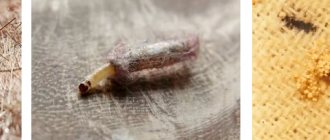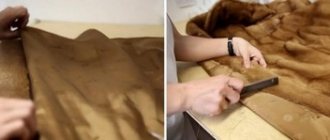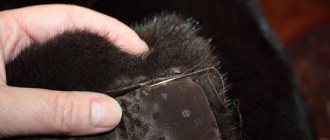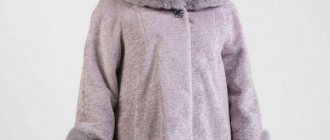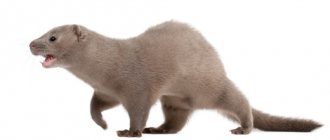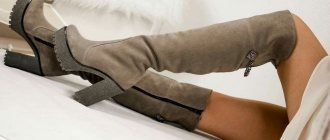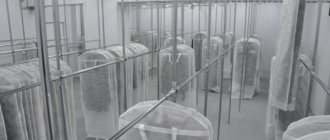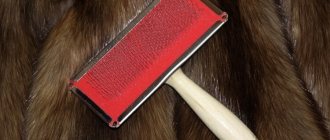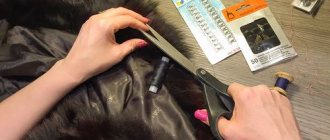The lightness, elegance and beauty of mink coats fascinate many representatives of the fair sex. Ladies of all ages have dreamed of such a gift at least once in their lives. However, such a product does not have high thermal insulation properties, so at low air temperatures such a fur coat may be too cold. Let's talk further in this article about how to insulate a thin mink coat yourself.
Insulating a mink coat
Advantages and disadvantages
Today, mink coats and short fur coats of varying prices have become available for sale, which makes them even more attractive for women and men. A rich palette of colors, shapes and cuts allows every fashionista to choose the option that will successfully emphasize the advantages of her figure and image, and at the same time at least slightly hide the shortcomings of her appearance.
Look at the following photo, a selection of mink beauties of different colors. Thin mink fur products are incredibly beautiful.
What other advantages do mink fur coats have? They are elegant and luxurious, stylish and sophisticated, lightweight and durable. But in fairness, we note that outerwear made of mink fur still does not have very excellent thermal insulation properties. What does this mean? In a too cold winter, such a product may not cope with one of its main functions, namely, to warm the fair sex. And reviews from many owners of mink products confirm the fact that a thin mink coat is not the warmest option for our climate.
GENERAL RECOMMENDATIONS FOR CHOOSING INSULATION
● as a base insulation material for eco-fur, we recommend choosing synthetic (Thinsulate, Waltherm, Isosoft, etc.) and a mixed type of insulation (Alpolux);
● You can use natural insulation, but we would recommend making it in the form of a detachable wool lining, removable or not, it doesn’t matter. ● for furs that have a mesh base, for an additional thermal effect, you can use membrane fabric. This type of fabric is designed to protect against bad weather, wind and moisture, thereby providing an additional feeling of comfort. So, you can make your fur coat less windy. Membrane fabric can be combined with insulation, or made instead of lining material. ● when choosing insulation, pay attention to its density. Before buying, apply insulation to the faux fur, see how they look together in volume, in movement, whether they give the same effect that you want. One way or another, we cannot recommend any specific density of insulation, since its choice is individual in nature and is selected solely from personal wishes and needs for how warm you want to make your product.
So, for ease of understanding, we present a special table as a visual aid, where, using an example, we will consider several insulation materials with an optimal density for eco-fur.
Note:
We would like to note that the thermal regime of eco-fur is determined by a relative value (in materials science there is no value for thermal conductivity or frost resistance of a given material), accordingly it can vary based on individual susceptibility to cold. Therefore, it is important and worth consulting on the issue of thermal conditions and the need for a membrane with a specialist who is directly involved in sewing products made from non-natural fur. In these matters, you must proceed from your personal wishes and needs. Also, if there is a need to insulate a fur product for a colder climate (-30 or more), take into account the thickness of the insulation, the density of the eco-fur pile and how they will look when applied to each other.
Tip: If you are not satisfied with the thickness of the insulation, but want to maintain its thermal properties, there is a way to deliberately reduce its thickness using a special technique - stitches
– verified!
Friends, we hope you found our article useful! We wish you productive creativity and a warm winter! Don't freeze! You can always buy faux fur wholesale or retail at Mirofox!
Technologies
Today, there are several technologies for insulating thin mink fur coats using the following materials:
- First of all, experts recommend insulating a beautiful mink fur coat using padding polyester. This is a fairly good insulating material, which is light weight and acceptable thickness. Thanks to these characteristics, a fur coat made with padding polyester will not become heavy and uncomfortable to wear;
- Also an excellent option for insulating a mink fur coat is wool batting. It is very warm, so it will help you stay warm even in very cold winters.
It is padding polyester and wool batting, according to many owners of mink coats and short fur coats, that do an excellent job of insulating outerwear made of mink fur. In addition, they are very easy to use, practical and not very expensive.
How to insulate yourself
You can insulate your mink beauty in a studio; this is not a very expensive service, but you need to be especially vigilant in choosing a specialist. After all, an inexperienced craftsman can not only do his job poorly, but also completely ruin your mink fur product.
You can also do all the work yourself and at home. To do this you will need insulation material, threads, scissors, a meter and a good mood.
Take measurements of your short fur coat first. Then cut out the material that you plan to use as insulation for the fur coat. Next, in order to insulate a short fur coat made from mink fur itself, it is necessary to steam the lining along the hem and collar of the product. Then, with special care, you will need to insert the insulating material inside the product from the hem to the collar. Now the material should be sewn to the lining, first along the top and then along the bottom.
Many experts do not recommend sewing insulation to the hem of a fur coat, as this can ruin its appearance. But if you do the work carefully and without haste, this will not happen.
The video below provides detailed instructions on how to make a mink fur coat warmer with your own hands and without the help of qualified specialists.
Leave your comment:
HOW TO CHOOSE QUALITY INSULATION
You can buy the best insulation for your fur coats from us: Insulation
So, we gradually approached the topic of how to actually choose the insulation itself. To begin with, we would like to draw your attention to such an important aspect, which is the essence of insulation, as air. Air is the best heat insulator. Therefore, the more still air there is in the insulation, the better and longer the clothing retains heat. And the lighter the fibers, the more cavities inside to hold air. Therefore, the most suitable option is lightweight insulation; it should be durable and wear-resistant, environmentally friendly and safe. It should not absorb moisture and foreign odors, lose shape, wrinkle and roll, shrink and become thinner during use. Also, you need to know about its density. There are different densities of insulation, the average value ranges from 100-300 g/m2. Insulation 100 g/m2 is suitable for spring and autumn. Insulation 180 g/m2 is best chosen for warm winters. For classic European winter or autolady, up to 200 g/m2 is suitable. Insulation over 300 g/m2 for cold winters at temperatures below minus 25 degrees. Super warm insulation with a density of 400 g/m2 is suitable for harsh climatic conditions.
After we have analyzed the general and detailed characteristics of basic insulation, then it is necessary to analyze the main material - this is artificial fur, for which the insulation itself is selected. In this particular case, we will work with our premium brand product Mirofox. As you already know, anyone who has worked with our product range is familiar with its basis, or rather, the types of basis. For those who haven't, we'll tell them. The assortment offers many beautiful options and whether to buy faux fur at retail or wholesale, they are all united by 3 main types of bases: loose mesh, dense mesh, knitted. Thanks to these types of weaving, fur has excellent plasticity, flexibility, can drape beautifully and play when moving. Accordingly, when choosing one or another type of insulation for it, it is necessary to take into account both its external and technological features: type of base, length and density of the pile. After a detailed review of the types of insulation, we can give a number of general recommendations for choosing a universal insulation for our eco-fur.
Caring for natural fur coats.
Soon the white flies will fly and the frost will hit. Will you take out your fur coat and what will you see? The fur has faded and caked, where it was damaged in general, well, you will have to spend your time correcting all the shortcomings and restoring the fur coat to its former beauty. Where do we start inspecting a fur coat - from the bottom, yes, and don’t be surprised, it’s from the bottom. In cities, roads and sidewalks are sprinkled with various chemicals, which inevitably ends up on the floors of fur coats and the process of destruction begins, in order to avoid this and return softness to the roughened flesh and plasticity, you need to apply a composition to the inside of the fur coat, which you can easily prepare at home yourself:
1. 20 g of table salt, 20 g of glycerin, 20 g of glucose (glycerin and glucose are sold at the pharmacy)
or
2. 2 tablespoons of vinegar essence and 3 teaspoons of salt per 1 liter of water.
Carefully rip off the lining - usually mink coats have the main lining and it is not sewn on completely, but has a free movement and under it along the hem of the fur coat there is a sewing strip from the bottom, so you need to rip it off, but not from the bottom, but from the top, try not to touch it, you yourself will not be able to put it back, but if the lining is sewn completely - in a circle, then open the side seam, turn the fur coat inside out.
Apply the mixture to the inside - !!!!!!carefully, without getting the product wet through!!!!!!!!!!! , then let the solution “sit” for 30-40 minutes and carefully wrap the floor around a rolling pin (with the fur inside) and roll it over an uneven surface, then stretch the flesh in different directions with your hands, but very carefully, if the damage was severe, the fur may burst. This will need to be repeated 2 times, every 3 hours, for better nourishment of the flesh.
Now let's examine the outside of the fur coat - if there are places where the fur has become matted - this is mainly in the back, where we sit on the fur coat, as well as under the arms and on the cuffs, then take a comb and begin to comb the fur without jerking, carefully untangling the lumps, this is good for this brush for cats, it is sold in any pet store, comb the fur in the natural direction of hair growth. If you see that the fur coat is dusty, then the best way to remove the dust is to moisten the sheet in a solution of water and 9% vinegar 1x1, wrap the fur coat in it and lightly beat it out, all the dust will settle on the wet sheet.
It will also help to refresh the color and remove various stains from a fur coat - a mixture of equal amounts of table vinegar, alcohol and water, which can be applied to the pile with a brush, then wipe the fur with a clean piece of cloth. And then, for complete drying, you need to hang the fur coat on wide and rounded hangers,
or
for about 1-2 days - but in no case near a battery or in the sun.
When the fur coat is completely dry, put a cotton cover on it - it is advisable to sew it from an old sheet or gauze and tie a sachet inside with herbs - wormwood or tansy, as well as lavender or jasmine flowers. The fur coat should hang in the closet in a spacious place - not in contact with other clothes and away from warm walls or radiators - fur loves the cold.
How to repair small tears in a fur coat.
If during the cleaning process the inner part comes apart in some places, then do not panic and do not run to the workshop, where they will charge you a lot of money for repairs. You can fix such small holes yourself. To do this, we take a medical adhesive plaster on a fabric basis - we lay out the place that needs to be repaired on a flat base and glue the adhesive plaster, having previously brought the tear points together. For better gluing, you need to tap the patch with a wooden hammer and then carefully sew along the edge of the patch with threads that match the fur, rest assured that the hole is securely fastened and will not go any further.
If you have any questions, write, I will try to answer, I have accumulated a lot of experience over many years of work, I will share what I know.
